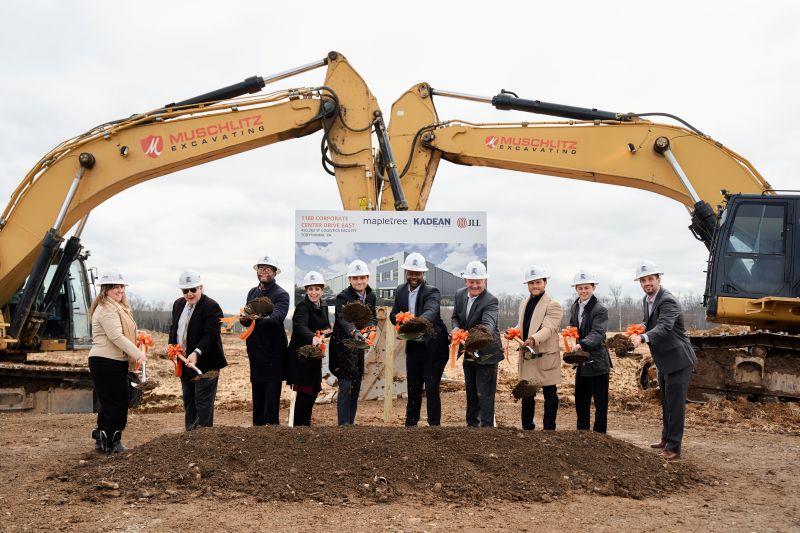CAF-AM promotes infrastructure investment in Paraguay – CAF – banco de desarrollo

CAF Approves Record US$5.2 Billion to Advance Sustainable Development Goals in Latin America and the Caribbean
Executive Summary
In a landmark meeting, the Board of Directors of CAF – Development Bank of Latin America and the Caribbean – approved a historic US$5.2 billion for 16 operations across 10 nations. This funding is strategically allocated to projects that directly support the United Nations’ Sustainable Development Goals (SDGs), focusing on infrastructure, climate action, human development, urban mobility, and energy transition. The institution also expanded its regional integration efforts, aligning with SDG 17 (Partnerships for the Goals), by welcoming Guatemala and St. Lucia as new shareholders, converting Barbados to a full member country, and increasing the capital of Antigua and Barbuda.
Project Allocations and Direct SDG Impact
The approved funds target critical areas of development, demonstrating a comprehensive approach to achieving the 2030 Agenda. The initiatives are designed to create lasting positive impacts on the environment, society, and economy across the region.
SDG 6: Clean Water and Sanitation & SDG 11: Sustainable Cities and Communities
Projects aimed at improving living conditions and ensuring access to essential services include:
- Argentina: A US$150 million loan for the “Sustainable Aqueduct System Program for the Province of Chubut,” directly advancing access to clean water (SDG 6).
- Colombia: A US$200 million loan to finance sustainable mobility projects in Bogota, enhancing public transport and creating safer, more inclusive urban environments (SDG 11).
- Peru: A loan of up to US$500 million to expand natural gas access in Lima and Callao, providing a cleaner energy source for urban populations (SDG 11, SDG 7).
SDG 7: Affordable and Clean Energy & SDG 13: Climate Action
Financing for the energy transition is a key priority, with projects focused on renewable sources and modernizing infrastructure:
- Bolivia: US$110 million in financing for the Chichas Solar Plant, a renewable energy project reinforcing Bolivia’s commitment to environmental sustainability (SDG 7).
- Bahamas: A US$100 million loan to support the modernization of electricity infrastructure and the expansion of renewable energy, improving affordability and resilience (SDG 7).
SDG 9: Industry, Innovation, and Infrastructure
Modernizing and building resilient infrastructure to foster economic growth and connectivity is central to several approved operations:
- Chile: A second financing phase of up to US$700 million to modernize and expand the national railway network, promoting sustainable transport (SDG 9, SDG 11).
- Colombia: A US$240 million loan to support Aerocivil’s Strategic Investment Plan, modernizing air navigation and airport services to strengthen regional integration (SDG 9).
- Regional: A US$250 million line of credit for the Sacyr Group to finance sustainable infrastructure projects, including water, sanitation, and social facilities across member countries (SDG 9, SDG 6, SDG 3).
SDG 15: Life on Land & SDG 13: Climate Action
Significant investments are being made to protect biodiversity, manage natural resources sustainably, and combat climate change:
- Colombia: A US$350 million loan for the “Program to Support Climate Action, Sustainability and Biodiversity” to address climate change and preserve natural heritage (SDG 13, SDG 15).
- Panama: A US$300 million credit to improve forest management, ecosystem conservation, and promote green financing (SDG 15).
- Costa Rica: Approval of a US$500 million green liquidity line, the first of its kind for the institution, to support environmental and climate-related initiatives (SDG 13).
SDG 3: Good Health and Well-being & SDG 16: Peace, Justice, and Strong Institutions
Funding is also directed towards strengthening social services and justice systems to build more equitable and peaceful societies:
- Colombia: A US$150 million loan to improve access to and quality of mental health services, particularly for vulnerable and excluded populations (SDG 3).
- Peru: An US$800 million line of credit for a program to improve the national penitentiary system, transforming conditions for persons deprived of liberty and strengthening justice institutions (SDG 16).
SDG 8: Decent Work and Economic Growth
To foster inclusive economic development, CAF is supporting the backbone of the region’s economies:
- Paraguay: A renewal and increase of a credit line to US$100 million for the Agencia Financiera de Desarrollo, with a special emphasis on financing for small and medium-sized companies (SMEs) to stimulate productive investment and job creation (SDG 8).
Conclusion: A Commitment to Integrated Development
As stated by CAF’s executive president, Sergio Díaz-Granados, “This has been a historic board of directors. Never before has CAF approved so many credit operations, nor such a large amount to finance the integral development of Latin America and the Caribbean.” This record approval underscores CAF’s role as a leading multilateral institution dedicated to filling financing gaps and promoting progress and well-being, directly contributing to the achievement of the Sustainable Development Goals across the region.
SDGs Addressed in the Article
The article highlights issues and projects connected to several Sustainable Development Goals (SDGs). These include:
- SDG 3: Good Health and Well-being: The article mentions a US$150 million loan to “improve access to and quality of mental health services” in Colombia, directly addressing health and well-being.
- SDG 6: Clean Water and Sanitation: The approval of a US$150 million loan for the “Sustainable Aqueduct System Program for the Province of Chubut” in Argentina and the mention of “drinking water and basic sanitation projects” clearly connect to this goal.
- SDG 7: Affordable and Clean Energy: The article details multiple energy projects, including the “Chichas Solar Plant in Bolivia,” the “modernization of the electricity sector in the Bahamas,” and the “expansion of access to natural gas in Lima and Callao,” all of which fall under this SDG.
- SDG 8: Decent Work and Economic Growth: The support for Small and Medium-sized Enterprises (SMEs) in Paraguay through a US$100 million credit line to “strengthen economic development and productive investment” is a direct contribution to this goal.
- SDG 9: Industry, Innovation and Infrastructure: This is a central theme, with funds allocated to “modernize critical infrastructure, such as the railroad network in Chile” and support for “Aerocivil’s Strategic Investment Plan” to modernize air navigation infrastructure in Colombia.
- SDG 11: Sustainable Cities and Communities: The article explicitly mentions investments in “urban mobility” and “promoting sustainable mobility, with investments in Bogota and Lima,” which are core components of creating sustainable cities.
- SDG 13: Climate Action: The article repeatedly emphasizes “climate action,” citing a US$350 million loan for Colombia’s “Program to Support Climate Action, Sustainability and Biodiversity” and CAF’s “first green credit for Costa Rica.”
- SDG 15: Life on Land: Environmental conservation is addressed through projects like the “biodiversity program in Colombia” and a US$300 million credit for Panama to “improve forest management and support… ecosystem conservation.”
- SDG 16: Peace, Justice and Strong Institutions: The approval of an US$800 million credit line to modernize “Peru’s justice and penitentiary system” directly targets the improvement of public institutions.
- SDG 17: Partnerships for the Goals: The entire article exemplifies this goal. CAF, a multilateral development bank, is partnering with 10 countries by providing US$5.2 billion in financing and expanding its membership to include Guatemala and St. Lucia to “deepen regional integration.”
Specific SDG Targets Identified
Based on the projects described, the following specific SDG targets can be identified:
- Target 3.4: Promote mental health and well-being. The loan to Colombia aims to “improve access to and quality of mental health services,” directly aligning with the promotion of mental health as part of this target.
- Target 6.1: Achieve universal and equitable access to safe and affordable drinking water for all. The project to improve the “aqueduct system in the Province of Chubut” is a direct action towards achieving this target for the residents of the mentioned cities.
- Target 7.1 & 7.2: Ensure universal access to modern energy and increase the share of renewable energy. The projects support both targets. The expansion of natural gas access in Peru for 9 million people addresses Target 7.1, while the construction of the “Chichas Solar Plant” in Bolivia and support for “expansion of renewable energy” in the Bahamas contribute to Target 7.2.
- Target 8.3: Promote development-oriented policies that support… micro-, small- and medium-sized enterprises. The credit line for Paraguay’s AFD is explicitly for “financing for small and medium-size companies,” which is the core of this target.
- Target 9.1: Develop quality, reliable, sustainable and resilient infrastructure. The modernization of Chile’s railway network and Colombia’s air navigation infrastructure are prime examples of developing sustainable and resilient infrastructure to support economic development.
- Target 11.2: Provide access to safe, affordable, accessible and sustainable transport systems for all. The US$200 million loan for “sustainable mobility projects in Bogota” as part of a plan to create a “safer, more inclusive and sustainable mobility system” directly corresponds to this target.
- Target 13.2: Integrate climate change measures into national policies, strategies and planning. The loans to Colombia and Costa Rica are designed to support national strategies and programs addressing climate change, such as Colombia’s “comprehensive strategy to address climate change” and Costa Rica’s green policies.
- Target 15.1: Ensure the conservation, restoration and sustainable use of terrestrial and inland freshwater ecosystems. The financing for Panama is intended to “improve forest management” and support “ecosystem conservation,” which is a direct implementation of this target.
- Target 16.6: Develop effective, accountable and transparent institutions at all levels. The program to “radically transform the conditions of persons deprived of liberty” by modernizing Peru’s penitentiary system is an effort to develop more effective and accountable justice institutions.
- Target 17.3: Mobilize additional financial resources for developing countries from multiple sources. CAF’s approval of US$5.2 billion in financing for 16 operations is a direct mobilization of financial resources from a multilateral source to support development in the region.
Indicators for Measuring Progress
The article mentions or implies several indicators that can be used to measure progress towards the identified targets:
- Financial Input Indicators: The most prominent indicator is the amount of financing allocated to each project. For example, US$150 million for mental health in Colombia, US$110 million for the solar plant in Bolivia, and US$800 million for Peru’s justice system. These figures measure the scale of the investment and commitment.
- Infrastructure Development Indicators: Progress can be measured by the completion of specific infrastructure projects. This includes the modernization of kilometers of railway track in Chile, the construction and operational capacity (in megawatts) of the Chichas Solar Plant, and the modernization of specific air navigation and airport facilities in Colombia.
- Access and Coverage Indicators: The article implies indicators related to the number of beneficiaries. For instance, the number of people in Chubut province with improved access to water from the new aqueduct system, or the “approximately 9 million people in Peru” who have access to natural gas from Cálidda’s network.
- Policy and Program Implementation Indicators: For goals related to climate action and institutional reform, an indicator is the successful implementation of the funded programs. This includes the execution of Colombia’s “Program to Support Climate Action, Sustainability and Biodiversity” and Peru’s “Program to Improve and Close Gaps in the National Penitentiary System.”
- Partnership and Integration Indicators: The expansion of CAF’s membership to include “Guatemala and St. Lucia” serves as a key indicator of strengthening regional partnerships and integration, a measure of progress for SDG 17.
Table of SDGs, Targets, and Indicators
| SDGs | Targets | Indicators |
|---|---|---|
| SDG 3: Good Health and Well-being | 3.4 Promote mental health and well-being. | Improved access to and quality of mental health services in Colombia, funded by a US$150 million loan. |
| SDG 6: Clean Water and Sanitation | 6.1 Achieve universal and equitable access to safe and affordable drinking water for all. | Implementation of the “Sustainable Aqueduct System Program” benefiting four cities in Chubut, Argentina. |
| SDG 7: Affordable and Clean Energy | 7.1 Ensure universal access to affordable, reliable and modern energy services. 7.2 Increase substantially the share of renewable energy in the global energy mix. |
Construction of the Chichas Solar Plant in Bolivia; expansion of renewable energy in the Bahamas; expansion of natural gas access to 9 million people in Peru. |
| SDG 8: Decent Work and Economic Growth | 8.3 Promote development-oriented policies that support… micro-, small- and medium-sized enterprises. | Increased financing (up to US$100 million credit line) for SMEs in Paraguay. |
| SDG 9: Industry, Innovation and Infrastructure | 9.1 Develop quality, reliable, sustainable and resilient infrastructure. | Modernization and expansion of Chile’s railway network; modernization of air navigation infrastructure in Colombia. |
| SDG 11: Sustainable Cities and Communities | 11.2 Provide access to safe, affordable, accessible and sustainable transport systems for all. | Implementation of sustainable mobility projects in Bogota to create a safer, more inclusive, and sustainable mobility system. |
| SDG 13: Climate Action | 13.2 Integrate climate change measures into national policies, strategies and planning. | Financing for Colombia’s “Program to Support Climate Action” and a US$500 million green credit line for Costa Rica. |
| SDG 15: Life on Land | 15.1 Ensure the conservation, restoration and sustainable use of terrestrial ecosystems. | Improved forest management and ecosystem conservation in Panama, supported by a US$300 million credit. |
| SDG 16: Peace, Justice and Strong Institutions | 16.6 Develop effective, accountable and transparent institutions at all levels. | Implementation of a program to modernize and improve Peru’s national penitentiary system. |
| SDG 17: Partnerships for the Goals | 17.3 Mobilize additional financial resources for developing countries from multiple sources. | CAF’s approval of US$5.2 billion for projects in 10 countries; inclusion of Guatemala and St. Lucia as new members. |
Source: caf.com

What is Your Reaction?
 Like
0
Like
0
 Dislike
0
Dislike
0
 Love
0
Love
0
 Funny
0
Funny
0
 Angry
0
Angry
0
 Sad
0
Sad
0
 Wow
0
Wow
0



















































.jpg.webp?itok=0ZsAnae9#)

























